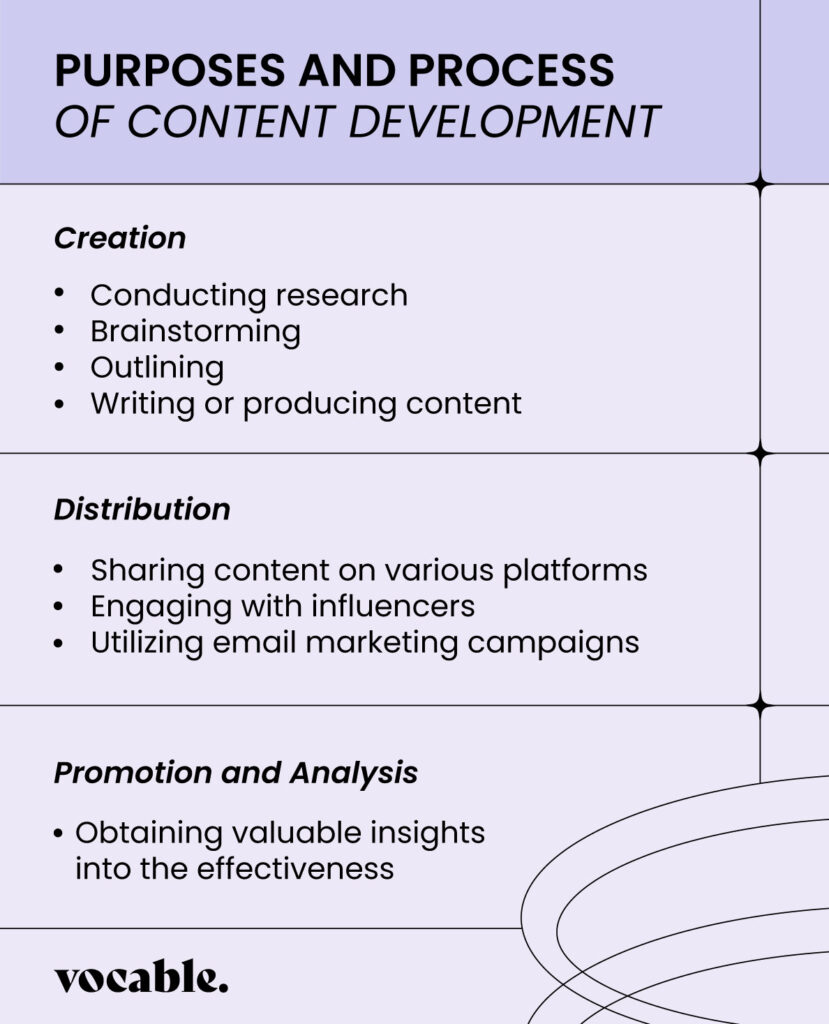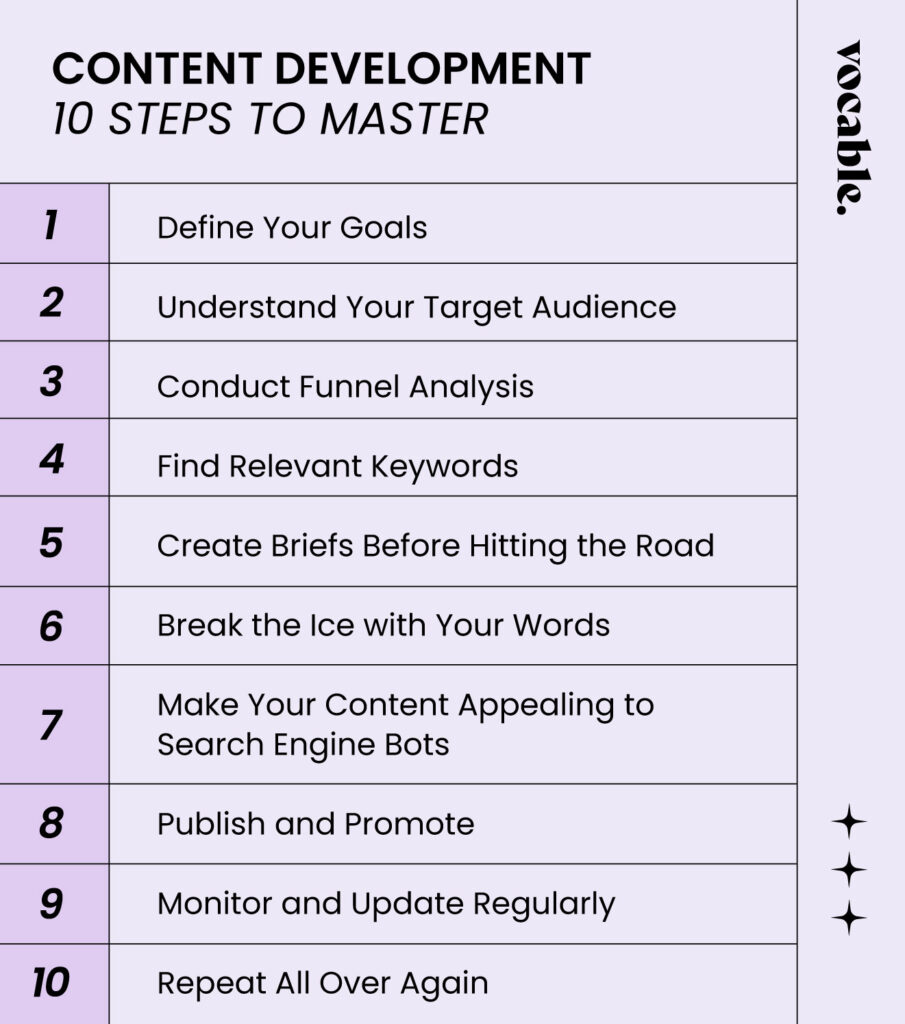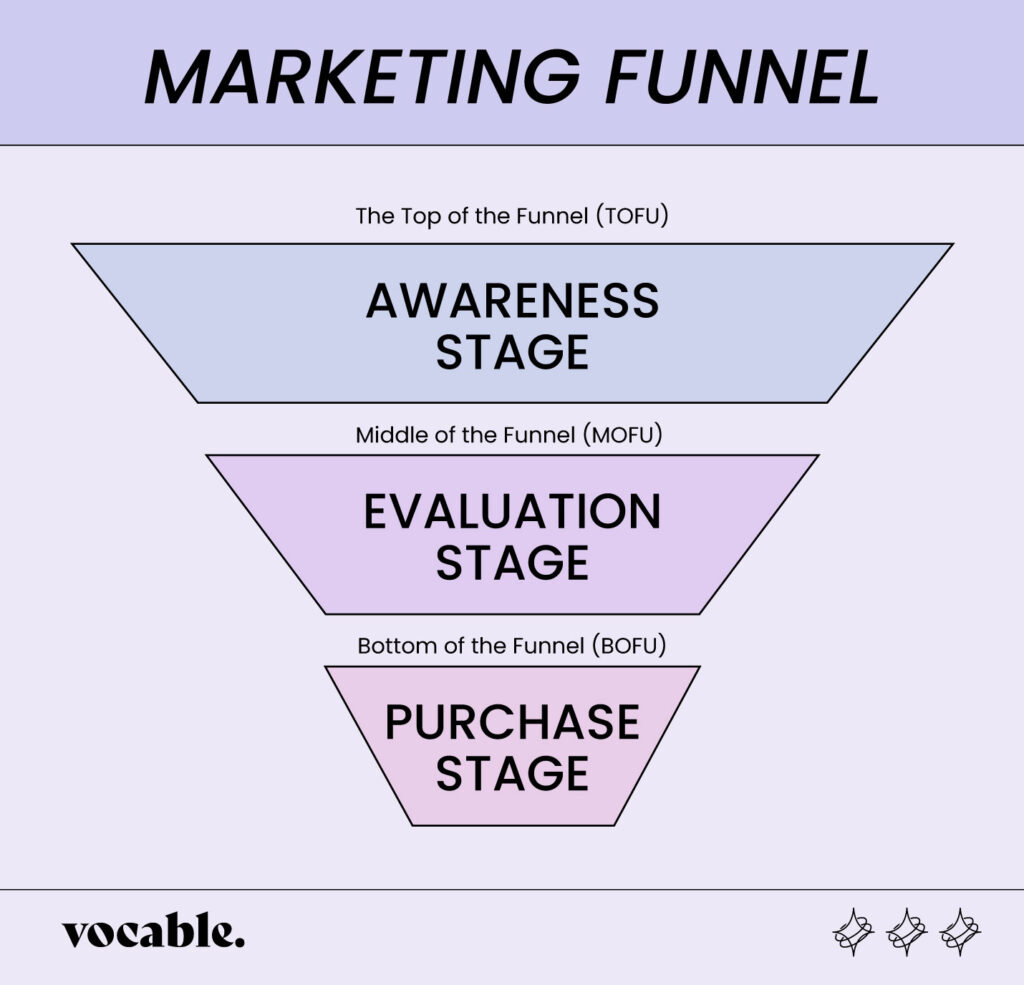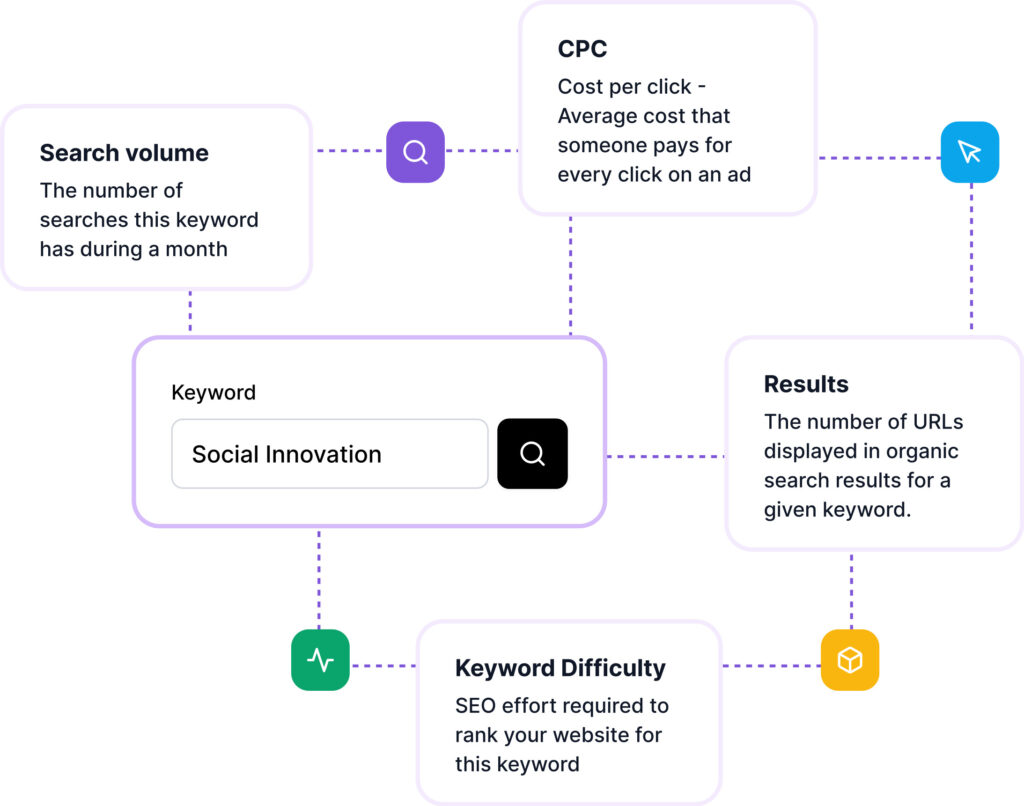Well, you’ve come to the right place!
In this comprehensive guide, we’ll walk you through the ins and outs of content development, sharing valuable insights, expert tips, and ready-to-use templates to streamline your process. Whether you’re a seasoned content writer, a freelance wordsmith, or a marketing specialist, this article is packed with valuable information just for you.
Content development is the backbone of any successful content marketing strategy. It’s the process of creating, organizing, and refining content to captivate your audience and achieve your goals.
And guess what? It’s not just about churning out words anymore.
In today’s digital landscape, the competition is fierce, and AI content development is making its mark.
But fear not! We’ll explore how human-created content still holds its ground and uncover the benefits of striking the perfect balance between the two.
So, grab your notepad and learn the secrets of successful content development. But before we dive in, let’s take a look at a few excellent examples that have set the bar high:
Now that you’re inspired, let’s uncover the essence of content development and discover how it can transform your content game.

What Is Content Development?
Content development is the backbone of every successful content marketing strategy. But what exactly does it mean? Let’s break it down.
Content development intends to communicate your message, engage the target audience, and drive desired outcomes. It’s about crafting compelling stories, informative articles, engaging videos, and other forms of content that resonate with your target audience.
Now, let’s explore the purposes and process of content development.

Creation
Content creation is where the magic happens. This is where you bring your ideas to life and transform them into captivating content that captures your audience’s attention. It involves conducting research, brainstorming, outlining, and writing or producing content. Whether it’s a blog post, a social media campaign, or a video, the creation stage is about delivering valuable and engaging content that aligns with your goals and target audience.
Distribution
Distribution
Yet, creating amazing content is only half the battle.
To maximize its impact, you need an effective distribution strategy. Distribution involves getting your content in front of the right eye at the right time. It includes sharing your content on various platforms, leveraging social media channels, engaging with influencers, and utilizing email marketing campaigns.
The goal is to reach your target audience, increase visibility, and generate the desired response from your readers or viewers.
Promotion and Analysis
After creating and distributing your content, it is essential to assess its performance and collect feedback for enhancing future endeavors. By closely examining metrics like engagement, conversions, and audience feedback, you can obtain valuable insights into the effectiveness of your content. These insights enable you to fine-tune your content strategy and optimize your future creations to achieve better results.
The choice of tools for analyzing content performance depends on the specific type of content you are working with. Here are several tool suggestions tailored to different content types:
- Google Analytics: A versatile analytics platform that offers detailed insights into user behavior, page views, bounce rates, and referral sources for your blog articles.
- SEMrush: Provides comprehensive keyword analysis, competitor research, and performance tracking to help optimize your blog’s organic visibility and traffic.
- Buffer: A social media management tool that allows you to schedule and track the performance of your posts across various platforms, providing analytics on engagement, reach, and clicks.
- Hootsuite: Enables you to manage and analyze your social media presence, providing metrics on follower growth, post engagement, and demographics.
- YouTube Analytics: A built-in analytics tool for YouTube creators, offering insights into video views, watch time, audience retention, and demographics.
The list goes on, so consider your audience and expectations to choose wisely.

What’s the Role of SEO Content Development?
When it comes to the digital world, SEO content development plays a crucial role in ensuring your content reaches the right audience and secures high rankings in search engine results.
But what exactly is SEO content development, and why is it so important?
SEO content development revolves around optimizing your content to make it more search engine-friendly. The primary goal is to increase organic visibility and drive targeted traffic to your website. By strategically incorporating relevant keywords, developing content strictly adhering to the search intent, and structuring it effectively you can enhance your chances of appearing at the top of search engine results pages (SERPs).
The purposes of SEO content development are twofold.
Firstly, it aims to attract and engage your target audience by offering them valuable and relevant content that addresses their needs and interests. Secondly, it aims to improve your website’s search engine rankings, leading to increased organic traffic, broader brand exposure, and higher potential for conversions.
SEO or Non-SEO?
To effectively differentiate successful SEO content development from non-SEO content development, it is crucial to consider several key aspects. Think of SEO as the secret ingredient that adds flavor and appeal to your content, making it more enticing and discoverable to your target audience.
While non-SEO content has its place and role in the marketing realm, most companies adhere to SEO practices to upscale their content faster and more effectively.
Here are a few core things to consider:
Comprehensive Keyword Research
In the world of SEO, keywords are like treasure maps that guide search engines and users to your content. Conducting thorough keyword research helps you uncover the exact terms and phrases your audience is actively searching for.
For example, in the fashion industry, you might discover that “sustainable fashion trends” or “eco-friendly clothing” are popular keywords. By skillfully incorporating these keywords into your content, you can effectively optimize it for search engines while providing valuable information to your audience.

Content Optimization
Just like a well-tailored suit or a perfectly fitted dress, SEO content needs to be optimized to ensure it looks and feels great to both search engines and users. This involves structuring your content in a user-friendly manner, using relevant headings and subheadings, and optimizing meta tags and URLs.
Additionally, integrating internal and external links to authoritative sources within your industry helps search engines understand the context of your content and boosts its credibility.
For example, in the technology sector, linking to reputable tech blogs or industry reports can enhance the trustworthiness of your content.
Measurable Impact
They say, “The proof of the pudding is in the eating.” Similarly, the impact of SEO-optimized content can be seen through statistical data and compelling graphs.
Analyzing organic traffic trends and conversion rates can provide concrete evidence of how SEO efforts contribute to increasing visibility, raising brand awareness, and driving valuable actions.
For instance, in the hospitality industry, tracking the rise in online bookings and reservations resulting from SEO-optimized content demonstrates its undeniable influence on the success of a hotel or resort.
Pro tip: Tools like Ahrefs, SEMrush, Google Analytics, Google Search Console, Moz, and others offer in-depth analysis and metrics to gauge the impact of your SEO content.
Keep reading to discover 10 pieces of professional advice to revolutionize your content development strategy. These insider tips, expert strategies, and practical templates are designed to take your content game to new heights!
10 Foolproof Steps to Master Content Development

1. Define Your Goals
When it comes to content development, the first and most crucial step is to define your goals clearly. Take the time to identify what you want to achieve with your content and how it aligns with your overall marketing strategy, business objectives, mission, and vision. This clarity will serve as your guiding light throughout the content creation process.
To better understand your goals, ask yourself the following questions:
- What specific outcomes do I want to achieve with my content?
- How does my content contribute to the larger marketing goals and objectives?
- Does my content align with the mission and vision of my brand or organization?
- How will my target audience benefit from consuming my content?
2. Understand Your Target Audience
To create impactful and engaging content, it’s essential to have a deep understanding of your target audience. By conducting thorough research, you can uncover valuable insights about their needs, preferences, and pain points. Here are some actionable tips to help you with this task:
Conduct Competitor Analysis: Study your competitors’ content and analyze their strategies. This can provide insights into what works well in your industry and help you identify gaps that you can fill with your own unique content. Tools like SEMrush and Ahrefs can assist you in conducting competitor analysis and identifying their top-performing content.
Perform Market Research: Dive into industry reports, market trends, and customer surveys to gather valuable data about your target audience’s demographics, behaviors, and preferences. This information can guide your content development and ensure it resonates with your audience. Websites like Statista and Pew Research Center offer comprehensive industry reports and demographic data.
Engage in Social Listening: Monitor social media platforms and online communities relevant to your industry. Observe conversations, identify pain points, and gather feedback to understand the needs and interests of your target audience. Tools like Hootsuite and Sprout Social can assist you in tracking and analyzing social media conversations.
Analyze Website Analytics: Utilize tools like Google Analytics to gain insights into your website visitors. Analyze data such as demographics, browsing behavior, and popular content to understand what interests your audience. This information can help you tailor your content to their preferences and improve user experience.
3. Conduct Funnel Analysis

In content development, understanding the marketing funnel is crucial for creating targeted and effective content.
A marketing funnel is a visual representation of the customer journey, from the initial awareness stage to the final conversion or purchase. It illustrates the various stages a potential customer goes through before making a decision.
Typically, the marketing funnel comprises three key sections:
- The top of the funnel (TOFU)
- The middle of the funnel (MOFU)
- The bottom of the funnel (BOFU)
Each segment represents a distinct phase in the customer’s progression, and understanding these stages allows content creators to tailor their approach accordingly.
The Top of the Funnel (TOFU)
At the uppermost part of the funnel, prospective customers are just entering the awareness phase. They may have a problem or need but aren’t yet familiar with your brand or solution.
Your goal here is to capture their attention and introduce them to your offerings. Think of this stage as casting a wide net to attract a broad audience. Engaging blog posts, informative videos, and engaging social media content can serve as effective hooks to draw them in.
Middle of the Funnel (MOFU)
As customers progress further into the funnel, they move into the middle stage. At this point, they have demonstrated interest and are actively seeking more information about your products or services.
Here, your content should focus on educating and nurturing prospects, and building trust and credibility. Case studies, expert guides, and webinars can effectively showcase the value of your offerings and help prospects make informed decisions.
Bottom of the Funnel (BOFU)
The final stage of the funnel is where prospects are primed to convert into customers. At this juncture, they have a clear understanding of their problem and are evaluating specific solutions.
Your content should be geared towards convincing them that your product or service is the ideal choice. Customer testimonials, product comparisons, and personalized demos can serve as persuasive tools to tip the scales in your favor.
Understanding of the funnel also enables you to align your content with the goals of each stage. For example, if you want to generate leads, you might create content that offers valuable resources or encourages sign-ups for newsletters. If your goal is to drive conversions, you might focus on creating content that highlights the unique selling points of your product or service.
Utilizing tools like Google Analytics, marketing automation platforms, or customer relationship management (CRM) systems can provide valuable data and insights to gauge the performance of your content at each funnel stage. These tools act as navigational aids, guiding you toward optimizing your content strategy to maximize conversions and nurture lasting customer relationships.
4 Steps for a Successful Funnel Analysis
Conducting a thorough funnel analysis is essential for optimizing your content strategy and improving conversions. Here are four key steps to guide you through a successful funnel analysis:
Define Your Funnel Stages
Typically, these stages include awareness, consideration, and conversion. This step helps you establish a clear framework for analyzing your funnel.
Identify Key Metrics
Determine the key metrics that align with each stage of your funnel. For example, at the awareness stage, you might focus on metrics like website visits or social media engagement. In the consideration stage, metrics like time spent on a page or email click-through rates are important. At the conversion stage, metrics such as lead conversion rate or sales revenue become significant.
Track User Behavior
Utilize analytics tools like Google Analytics or Hotjar to track user behavior at each funnel stage. Analyze data such as page views, click patterns, and drop-off rates to identify any bottlenecks or areas for improvement. This step provides valuable insights into how users navigate through your funnel and where you may be losing potential customers.
Optimize and Test
Based on the insights gained from your analysis, make data-driven optimizations to your content and user experience. Test different variations of your content, landing pages, or calls to action to identify the most effective elements. Continuous testing and optimization will help you refine your funnel and maximize conversions.
4. Find Relevant Keywords
To improve the visibility and SEO of your content, it’s crucial to identify relevant keywords and strategically incorporate them into your content. Conducting effective keyword research is the key to achieving this.
Let’s explore the steps involved in conducting keyword research that work.
Understand Your Target Audience
Gain a deep understanding of your target audience, considering their demographics, interests, and pain points. This knowledge will help you select keywords that align with their needs and preferences.
Brainstorm Seed Keywords
Begin with a list of seed keywords that are relevant to your content or industry. These broad terms capture the main topics or themes of your content. Think about what your audience might search for when looking for content similar to yours.
Utilize Keyword Research Tools
Tools like Ahrefs and SEMrush can help you greatly with this.
However, as technology advances, AI takes the central stage and offers more enhanced capabilities. Vocable’s AI-powered keyword researcher goes beyond the basics of search volume and competition to provide a comprehensive understanding of keyword performance. It provides valuable insights into keyword search volume, competition, and related keywords.

Unlock untapped opportunities and gain a competitive edge by identifying keywords that are driving traffic to your competitors’ websites.
Analyze Long-Tail Keywords
Explore long-tail keywords, which are more specific, and target niche search queries. While they may have a lower search volume, they often indicate higher user intent. Incorporating relevant long-tail keywords into your content can attract qualified traffic and improve your search rankings.
Consider User Intent
Delve into the intent behind a keyword. Ask yourself, what is the searcher trying to achieve? Are they seeking information or a solution, or are they ready to make a purchase?
Aligning your content with user intent enhances relevance and engagement.
Evaluate Keyword Difficulty
Assess keyword competitiveness by examining metrics like keyword difficulty or competition score. This helps prioritize keywords that are within reach and have a higher chance of ranking.
When conducting keyword research, remember to incorporate keywords into your content naturally. Avoid keyword stuffing, as it harms user experience and SEO.
Vocable’s AI-powered keyword research tool is a valuable resource helping you explore customer-specific trending queries and discover what’s relevant to your content strategy. Vocable’s Ideation Tool also assists in generating topic ideas.

5. Create Briefs Before Hitting the Road
Having a well-crafted and detailed brief assigned to writers is essential for successful content development. It provides clear guidance and direction, ensuring writers understand the objectives, target audience, key messaging, and project requirements.
Introducing Vocable, a platform that offers AI-powered briefing templates, further enhances the content creation process. These templates save time by guiding writers through the necessary steps of creating a brief and promoting consistency and clarity.

With Vocable’s AI-powered templates, writers can include important details such as project goals, target audience insights, preferred tone and style, and key messaging. This streamlined approach fosters collaboration and communication between content managers and writers, leading to a more efficient content development process.
By utilizing Vocable’s AI-powered briefing templates, you can save time, enhance collaboration, and create content that effectively communicates your intended message. Craft well-defined briefs with Vocable and set the foundation for successful content development.
Lastly, Vocable’s AI-powered templates facilitate collaboration between content managers and writers. They provide a centralized space for communication, feedback, and revisions, fostering a seamless workflow and ensuring everyone is aligned throughout the content development journey.
6. Break the Ice with Your Words
Writing engaging and compelling articles is a crucial step in content development. It’s where ideas come to life, and connections are made with the audience. Whether you’re an experienced writer or just starting out, here are some suggestions to help you write a great article.
Craft a Captivating Introduction
Start with an attention-grabbing opening that hooks your readers and sets the tone for the rest of the article. Pose a thought-provoking question, share an intriguing anecdote, or present a surprising statistic.
Outline Your Structure
Organize your article into clear sections or subheadings. This not only improves readability but also helps you stay focused and ensures a logical flow of ideas. Use bullet points, numbered lists, or bold headings to break up the text and make it skimmable.
Provide Valuable Insights and Information
Deliver on the promise of your headline by offering valuable content. Share your expertise, provide practical tips, or present in-depth research. Back up your points with credible sources, statistics, or case studies to establish credibility and build trust with your readers.
Engage with Your Audience
Write in a conversational tone that connects with your readers. Use personal anecdotes, relatable examples, or storytelling techniques to make your content more relatable and engaging. Encourage reader interaction by asking questions, inviting comments, or including interactive elements like quizzes or polls.
When it comes to generating unique ideas or enhancing your writing process, AI writing tools can be valuable resources. Vocable’s AI writing tools offer advanced capabilities beyond what traditional AI models like ChatGPT can provide. They can assist in generating topic ideas, optimizing content for SEO, and even generating content drafts based on your specifications.

7. Make Your Content Appealing to Search Engine Bots
When it comes to content optimization, there are several key aspects to consider to make your content more visible and appealing to search engine bots. By understanding these important elements, you can enhance your chances of ranking higher in search engine results pages (SERPs) and driving organic traffic to your website.
Corresponding to Search Intent
Ensure that your content aligns with the search intent of your target audience. Focus on providing valuable information, answering their questions, or solving their problems. This helps search engines recognize the relevance of your content and deliver it to the right audience.
Proper Keyword Placement
Incorporate relevant keywords naturally throughout your content. Avoid keyword stuffing, which can negatively impact your rankings. Instead, use keywords strategically in the title, headings, body text, and meta tags to signal to search engines what your content is about.
Optimal Content Length
Aim for an optimal content length that provides comprehensive coverage of the topic. While there is no specific word count that guarantees success, longer content tends to perform better in search results. However, prioritize quality over quantity, ensuring that your content is well-structured, engaging, and informative.
Image and Multimedia Optimization
Optimize your images and multimedia elements by using descriptive file names, relevant alt text, and compressed file sizes. This improves accessibility, user experience, and search engine indexing of your visual content.
Meta Tags
Pay attention to meta tags, including meta titles and meta descriptions. Craft compelling and concise meta tags that accurately represent your content and entice users to click through to your website from the search results.
External and Internal Links
Incorporate relevant external and internal links within your content. External links to authoritative sources add credibility to your content, while internal links help users navigate your website and improve its overall structure.

8. Publish and Promote
After double-checking that all metadata is polished and optimized for SEO, it’s time to hit the publish button and make your content live. But don’t stop there! To maximize its reach and impact, you need to promote your content across various platforms actively. Here are some effective strategies to consider:
Sharing with Target Users via Email Campaigns
Leverage your email list and send targeted email campaigns to share your new content directly with your audience. Personalize the emails and highlight the value and relevance of the content to encourage engagement and click-throughs.
Repurposing and Multi-channel Promotion
Repurpose your content into different formats to reach a wider audience. Convert it into social media posts, create podcast episodes, or develop infographics. Adapt the content to suit each platform’s requirements and engage with your audience in different ways.
Authoritative Link Building
Building authoritative links to your content is crucial for SEO and increasing its visibility. Reach out to relevant websites, influencers, and industry experts and ask them to link to your content. This helps drive traffic, boosts your content’s credibility, and improves its search engine rankings.
9. Monitor and Update Regularly
Regularly monitoring and updating your content is essential to maintain its relevance, accuracy, and value over time. By doing so, you send signals to search engines that your content is current and valuable, which can positively impact your search engine rankings. Here are some practices to consider:
Content Audits
Conduct regular content audits to evaluate the performance and effectiveness of your existing content. This involves assessing factors such as traffic, engagement metrics, and conversions.
Tools like SEMrush, Google Analytics, and Ahrefs can provide valuable insights to help you identify content that needs updating or optimization.
Performance Tracking
Use tools to track the performance of your content over time. Monitor key metrics like organic search rankings, traffic sources, click-through rates, and conversion rates. This data can help you identify trends, spot opportunities for improvement, and make data-driven decisions to enhance your content strategy.
Content Refresh and Optimization
Based on the insights gathered from your content audits and performance tracking, update and optimize your content accordingly. This may involve adding new information, improving the structure and readability, optimizing keywords, or incorporating relevant multimedia elements. By keeping your content fresh and valuable, you can maintain its visibility and relevance in search engine results.

10. Repeat All Over Again
Content development is not a one-time task but a continuous process that requires consistent effort and dedication. If you want to see tangible results and avoid wasting time, it’s important to understand that content creation and optimization should be an ongoing endeavor.
Here’s why:
Audience Engagement
Your audience’s needs, preferences, and expectations evolve over time. By regularly creating and updating content, you can keep up with their changing interests and ensure that your content remains relevant and engaging. This ongoing interaction with your audience helps to build trust and loyalty.
Search Engine Optimization (SEO)
Search engines constantly update their algorithms to deliver the most relevant and valuable content to users. By regularly optimizing your content with relevant keywords, high-quality backlinks, and user-friendly formatting, you can improve your search engine rankings and attract organic traffic. Staying up-to-date with SEO best practices is crucial for maintaining visibility in search results.
Industry Trends
The digital landscape is ever-evolving, with new technologies, trends, and competition emerging regularly. To stay ahead of the curve, you need to continuously monitor industry trends, research new topics, and adapt your content strategy accordingly. This ensures that you remain relevant and competitive in your field.
Performance Analysis
Monitoring and analyzing the performance of your content is essential for understanding what works and what doesn’t. By regularly reviewing metrics such as website traffic, engagement rates, and conversion rates, you can identify areas for improvement and make data-driven decisions to enhance your content effectiveness.
Streamline Your Content Development Process
In today’s fast-paced digital world, streamlining your content development process is essential for creating high-quality, engaging, and effective content. By following a structured approach and incorporating key strategies, you can optimize your content creation, ensure efficiency, and achieve better results.
Here’s how you can streamline your content development process:
Planning and Strategy
Start by setting clear goals and objectives for your content. Identify your target audience, understand their needs and preferences, and conduct thorough research to gather valuable insights. Develop a comprehensive content strategy that aligns with your brand voice, values, and business objectives.
Research and Ideation
Conduct in-depth keyword research, competitor analysis, and topic exploration. Leverage tools like Ahrefs, SEMrush, and Vocable’s AI-powered keyword research tool to discover relevant and trending topics. Generate creative ideas and brainstorm content angles that resonate with your target audience.
Content Creation and Optimization
Craft well-structured, engaging, and informative content that addresses the pain points of your audience. Incorporate relevant keywords strategically and ensure proper keyword placement without resorting to keyword stuffing. Optimize your content for search engines by paying attention to meta tags, proper formatting, and multimedia elements.
Collaboration and Workflow
Establish a streamlined workflow and efficient collaboration process within your content development team. Clearly define roles and responsibilities, set deadlines, and utilize project management tools to facilitate seamless communication and task management.

Measurement and Analysis
Regularly track and analyze the performance of your content. Monitor metrics such as website traffic, engagement rates, conversion rates, and social media shares. Identify areas for improvement, make data-driven decisions, and continuously optimize your content strategy based on insights gathered.
Embrace Multi-Team Collaboration with Vocable
Vocable software simplifies multi-team collaboration, making content development a breeze.
With shared workspaces, real-time editing, and task assignment, teams can seamlessly work together. It fosters communication, transparency, and accountability, boosting efficiency and productivity.
Vocable promotes knowledge sharing and empowers team members to contribute their expertise. Its intuitive interface ensures accessibility for all users.

By centralizing content-related activities, Vocable enhances organization and project management. Embrace Vocable to revolutionize collaboration, drive exceptional results, and create outstanding content in a harmonious environment.
The Bottom Line
In conclusion, having a well-thought-out content development strategy is crucial for success in today’s digital landscape. With Vocable’s powerful tools and resources, you can streamline your process, enhance collaboration, and drive exceptional results. Don’t miss out on the opportunity to elevate your content strategy and achieve your goals.
Embrace Vocable and unlock the true potential of your content development efforts.



